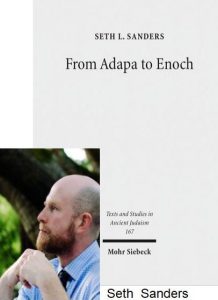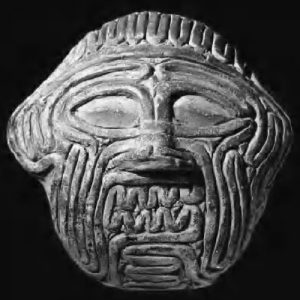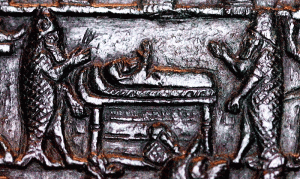 Continuing to share my reading of Seth Sanders’ From Adapa to Enoch, Scribal Culture and Religious Vision in Judea and Babylon, last discussed at Ascent of the Sage: “From Adapa to Enoch”, part 2 . . . .
Continuing to share my reading of Seth Sanders’ From Adapa to Enoch, Scribal Culture and Religious Vision in Judea and Babylon, last discussed at Ascent of the Sage: “From Adapa to Enoch”, part 2 . . . .
We come now to chapter 2, “I Am Adapa!” The Divine Personae of Mesopotamian Scribes.
If we want to understand how ancient scholars related to their universe, their revealed texts and revealers, the best collections of sources we have, spanning two to three thousand years up to the first century CE, are the cuneiform records of Mesopotamia. In the next chapter Sanders begins to compare Judean texts.
In this chapter (2) Sanders examines the nature of the cosmos among these ancient scribes and how they went about understanding, studying and acting on it.
In addition to the texts, there is the visual imagery of divine beings, divine sages or apkallu, to help us with our inquiry.
We have images of a patient (sick, hence possessed or inflicted by a demon) surrounded by superhuman fish-apkallu standing where exorcists would be positioned.
We have royal inscriptions of the enthroned king framed by bird-apkallu maintaining cosmic order from the seat of royal power.
Scholarly participation in supernatural presence was not confined to exorcism: the economists and political scientists of their day, diviners summoned the gods to meet together in divine assembly so that the diviner could be present to hear and transmit their verdict for the country’s future. (Sanders, 72)
“Medical practice” and “political advisors” were thus the more practical pursuits of scholars. But what are the boundaries between science and what we would relegate to mumbo-jumbo in their world? And did the scholars or scribes really become, in their own minds, supernatural sages (apkallu)? Did they really believe they could journey to heaven and meet with the gods?
At this point we find an interesting connection with another book I have been posting about. It is interesting to compare the concepts of early Judean scribes to their Hebrew text — see the two posts on Nanine Charbonnel’s chapter 2, The Sacred and Creative Power of the Hebrew Text and A God Bound to the Mechanics of Language. Seth Sanders writes,
If cuneiform was the secret of Mesopotamian scribes, the ultimate decipherer of this secret was the semi-human sage Adapa, at once the symbol and the patron saint of the scribe. Probably the single most popular mythic hero in Mesopotamian literature, Adapa beat out even Gilgamesh. As Michalowski notes, “no other hero of a canonical text is so often encountered in other compositions.” This is not surprising, since he would have been so sympathetic to the scribes who produced those compositions. He is supposed to have authored omen collections, fathomed the deepest secrets of words and magic, and broken the wings of the South Wind by the sheer power of his speech. He was of paramount importance to the people who created cuneiform culture.
Adapa is crucial as a phenomenological starting point in our comparison of scribal heroes. As the best-documented ancient Near Eastern figure who ascends to heaven, negotiates with gods, transmits revelation, and fights demons to heal the sick he is simultaneously the closest thing Mesopotamia has to Moses, Enoch and the shaman of North Asian societies. Seen horizontally, from a view of cultures side by side, he represents a broad comparative type: the mediator, who moves between the worlds of gods and humans. (Sanders, 73. My bolding in all quotations)
Adapa is a figure of knowledge and power (see the previous post in this series). He is also worn as a ritual mask. And as we saw in the previous post, his function changes over time as political circumstances change.
In order to grasp something of the way the natural and divine worlds were conceptualized in Mesopotamian culture we need to set aside our dualistic notions of spirit powers and entities. To us, the spirit realm stands against the natural world, yet such a division between the two needs to be set aside, Sanders emphasizes at length. We think of God and spirit beings as not found literally in physical manifestations like idols of stone, or in natural phenomena like earthquakes and storms.
Mesopotamian texts and images portray the divine beings interacting with, present with, humans, both occupying the same space, and in some cases the human speaker actually claims to be the divine Adapa himself.
I am Adapa sage of Eridu [= location of watery source of secret knowledge]
I am the man [= servant] of Asalluhi [= the god of exorcism]
Enki [= creator and master of the demons causing the illness] the great lord has sent me to cure the man in his illness!
In what sense did the speaker understand himself to be Adapa?

Advances in understanding the Mesopotamian view of the supernatural vis a vis the natural world have come, Sanders explains, through exploring more deeply the nature of Mesopotamian science. And here I take a detour to have a closer look at some of the sources Sanders calls upon, work by the Assyriologist Francesca Rochberg.
Before the “World of Nature”
Imagine not having a concept of “the natural world” or “nature”. We take the concept for granted and that makes it difficult for us to appreciate that it has not always existed.
A key insight has come from the history of science. Exploring Mesopotamian scholars’ criteria for meaning and truth, Francesca Rochberg has shown that cuneiform scholarship tended to see the material world as composed of signs: reality itself is semiotic. Such an ontology does not presuppose a purely non-linguistic physical nature in opposition to culture, and in fact the history of science has shown that an explicit concept of nature is not necessary to all scientific inquiry, citing ancient China and Mesopotamia as cases where forms of science thrived without it (Lloyd 2012:64). (Sanders, 77)
What were the “subjects” of interest to Mesopotamian scholars?
Various forms of divination: astronomy and astrology, examination of sheep’s entrails, lexical texts (lists of synonyms, grammatical forms, etc.), diagnostic and therapeutic medical texts, magical texts, incantations . . .
Understanding the intersections of omen divination, magic, medicine, and the hermeneutics that methodologically join these disciplines to the lexical material and to each other will be key to writing a history of cuneiform science in the future. In essence, the totality of scribal learning, kullat ṭupšarrūti “everything pertaining to the scribal art,” is source material for the history of cuneiform science as seen from a more or less internal perspective.
An illustration of the character of divination:
Let us again take the omen “If Jupiter becomes steady in the morning, enemy kings will be reconciled.” To accept the empirical association of P and Q is to presume that at some time in the past it was observed that following the steadiness of Jupiter in the morning, enemy kings were reconciled, and further, to justify on the basis of that empirical connection future predictions about enemy kings being reconciled whenever Jupiter is “steady.” But this omen is simply built upon an analogy drawn between the elements of the protasis, that is, Jupiter, Marduk’s star, connoting rulership, and its “steadiness” (expressed with the verb kânu) connoting rectitude and stability, and the elements of the apodosis, that is, peace between enemy kings. The same is true for instances of paranomasia (sic) between words in the antecedent and consequent. For example, in the extispicy series (Clay 1923: no. 13:65): “If the coils of the intestine look like the face of Huwawa (written logographically *’HUM.HUM): it is the omen of the usurper king (also written logographically, IM.GI = Akkadian hammā’u) who ruled all the lands.”

Here the antecedent is related to the consequent by a wordplay based on the homophonous echo of HUM.HUM in hammā’u, not by any empirical connection between intestines coiled that way and a usurpation. The homophony pertains between the logogram ‘’HUM.HUM in the protasis and the Akkadian reading of the logogram IM.GI in the apodosis. The antecedent-consequent connection, therefore, is based upon a homophonic play that requires and even presupposes a sensitivity to orthographic practice of the highly trained cuneiform scribe. Though the meaningful connection between antecedent (intestinal coils appearing as the face of Huwawa) and consequent (usurpation) is based on the phonetic play between words, the image (above) refers to the visual aspect of the imagery conjured by the protasis alone. Regarding the connection between protasis and apodosis, the omens illustrate scribal invention involving the sounds, meanings, writings, literary allusions (e.g.. Clay 1923: no. 13:33, in which the coils looking like an eagle are read as “the omen of Etana,” who ascended to heaven on the back of an eagle), as well as visual analogies between elements, such as might be constructed between the appearance of a cuneiform sign and what it signifies: “If the coils of the intestine look like a PAP-sign: your capital will prosper over the enemy ‘s capital.” Here the PAP-sign, two crossed wedges, is visually iconic for the notion of conflict. Or, coils that appear as a kubsu-cap . . . , the headdress associated most particularly with royalty (or divinity), are read as significant for the “throne,” again by an iconic means of sign representation.
(Rochberg, 2010, 19-20)
To expand a little on that,
The resulting holistic approach to cuneiform intellectual historical sources, therefore, sees astronomy together with divinatory texts, horoscopes (Rochberg 1998), astral-medicine, and other kinds of divination (extispicy, morphoscopy, terrestrial omens, etc.), all representative of a system aimed at understanding the interconnection of human, divine, and world, both in its physical aspect and its textual representation. Essential to this historiographical approach is the dissolution of former demarcations between science and other forms of knowledge or practice . . . . (Rochberg, 2014, 40)
Observation of phenomena was motivated largely by an interest in ominous signs, not the desire to causally account for those phenomena. And because there was no conception of nature to provide a framework of laws or forces to account for such causes, the scribes did not seek to explain phenomena in a causal way (Rochberg 2011). Explanation in the cuneiform intellectual world had other aims, generally hermeneutic in character (Frahm 2011). (Rochberg, 2014, 44)
What is science, then?
Peter Harrison noted (1998: 8–9) that “for virtually the first fifteen hundred years of the common era the study of natural objects took place within the humanities, as part of an all-encompassing science of interpretation which sought to expound the meanings of words and things.” The contexts and methods that characterize ancient Mesopotamian knowledge of what Harrison called “natural objects,” roughly for the fifteen hundred years before the Common Era, have quite a number of parallels to what he described for the first fifteen hundred years. That is, natural objects – or what we call natural objects – were classified within a framework of things and kinds that had significance as signs coming from the divine for the benefit of human society. Cuneiform testimony about signs and portents did not yet draw lines between or around the natural, supernatural, or preternatural, none of which domains can exist in the absence of a conception of nature itself. (Rochberg, 2014, 52-53)
To take one particularly interesting type of divination (paronomasia), interpretations of, say, a sheep’s liver could be based entirely on sounds, spellings or meanings of words, similarities to the visual appearance of cuneiform representations of what is being perceived as the sign. It was a task for the highly trained literate scribe. Divination was not random or fatuous interpretations. It was a “logical and systematic” practice of the learned. Relations between different phenomena are not the sort that we would make today, but within their own cultural perspectives they were logically valid.
Is science an appropriate term to apply here? Rochberg notes,
The same question has been addressed with respect to pre-nineteenth-century sciences in general (Cunningham 1988; Cunningham and Williams 1993; Cunningham and French 1996). But to limit the discussion of what the nature of ancient Babylonian divination is by erasing the term “science” from our discourse about it leads us back to the dichotomy of science and non-science, science and religion, or worse, science and superstition. If the term “science” is confined to the modern era, as Peter Dear has discussed in his critique of Cunningham’s thesis (2001), medieval and renaissance science, including natural philosophy and the physical and mathematical sciences also end up on one side of a great divide between science and non-science. Dear’s sensitive critique argues for further refinement of the categories science and natural philosophy and their relation to religion, and a finer-grained empirical as well as historicist treatment of sources in terms of which the sciences are defined. (Rochberg, 2010, 23)
Rochberg argues for Mesopotamian divination (and other branches of study) to be included in the history of science.
Focussing on formal considerations of the omen texts has uncovered the logical and systematic nature of these texts as a direct result of their conditional form. Their logical, systematic, and inferential character, I would argue, warrants classification with science. Other aspects of cuneiform divination, particularly those involving the practice (as opposed to the nature) of divination, indicate other possible classifications, for example, with magic or religion. The problem is that none of these categories are found in Akkadian terminology, though there are words for observe … and predict …, apotropaic ritual …, incantation …, and gods ….
The category “non-science,” on the other hand, does not seem to be useful as its purpose is to set what we now hold to be justified correct scientific knowledge apart from unjustified or wrong belief. This has the mouthfeel of morality rather than history. (Rochberg, 2010, 23-24)
The Social and Cultural Matrix of Knowledge and Inquiry
Another word Rochberg deems inappropriate for Mesopotamian scholarship is “superstition”.
Correspondingly, the history of the use of the term “superstition” further demonstrates its inapplicability to Mesopotamia. The pejorative meaning of the Latin superstitio stems from the first-century B.C. Roman condemnation of divination not sanctioned by the State, later having the force of “unreasonable religious belief,” as opposed to religio, the reasonable, or proper, fear of the gods (Salzman 1987: 174 and nn. 10 and 14). Legislation in A.D. 297 against illicit divination and superstitio was an ideological and political tool, aimed against sorcerers and Manichaeans, not against the practice of divination in principle. Because of its origins, the use of the term “superstition” in historical analysis, unlike use of the term “science,” can only have an invidious effect, connoting wrong belief. Despite the diversity of the cuneiform divination corpora, there is no evidence of ideological conflict such as that between orthodox and unorthodox divination in the Roman principate. More importantly, no distinction was ever invoked in cuneiform texts between say, astronomy and astrology. This is clear in the late Uruk tablet which gives effective rules not only for predicting month lengths and lunar eclipses from empirical data available in the astronomical diaries, but also contains sections for use in predicting worldly events of a political nature . . . (Rochberg, 2010, 24)
Interestingly, Rochberg refers to D. Martin to make the observation that the historical rejection of superstition was not the result of learned people becoming more rational and empirical in their thinking but rather because beliefs in gods shifted.
Furthermore, D. Martin has argued that the rejection of superstition was not “due to the rise of ‘rationalism’ or ’empiricism’ in the ancient world” (2004: 230). He shows that the investigation of the natural causes of disease was due to a shift in belief about the nature of the gods, that they were incapable of perpetrating evil. Martin continues.
ancient intellectuals never demonstrated that the gods were good; they assumed it. They did not discover new “evidence” about the nature of the divine…. No, the rejection of divine and daimonic causation of disease did not come about simply because certain Greek men were suddenly “rational” thinkers whereas all their countrymen were “irrational,” nor because they suddenly became “empiricists” whereas their countrymen couldn’t see nature in front of their faces. The modernist depiction of ancient “science” as caused by a development of “empiricism” or “rationality” is misleading and ultimately not supported by the evidence. Rather, we must look to ancient social and cultural sources for the invention of “superstition” (Martin 2004: 230).
Why this observation is relevant to the study of Mesopotamian divination is precisely that, even though our evidence does show an underlying rationality, its classification as “science” on that basis is only part of the story. We still need to look to the larger social and cultural context and put the rational dimension into a more complex whole of meanings, methods, and practices that constituted prognostication by means of ominous signs in ancient Mesopotamia. (Rochberg, 2010, 24-25)
Time to return to Sanders’ chapter. . . .
Rochberg, Francesca. 2014. “The History of Science and Ancient Mesopotamia.” Journal of Ancient Near Eastern History 1 (February). https://doi.org/10.1515/janeh-2013-0003.
Rochberg, Francesca. 2010. “‘If P, Then Q’: Form and Reasoning in Babylonian Divination.” In Divination and Interpretation of Signs in the Ancient World, edited by Amar Annus, 19–27. Oriental Institute Seminars 6. Chicago, Ill.: The Oriental Institute of the University of Chicago.
Sanders, Seth L. 2017. From Adapa to Enoch: Scribal Culture and Religious Vision in Judea and Babylon. Tübingen, Germany: Mohr Siebeck.
(A book by Rochberg that appears to be most relevant to Sanders’ discussion was published in the same year as From Adapa to Enoch. When I have a chance to read something of this recent publication of Rochberg’s, Before Nature: Cuneiform Knowledge and the History of Science, no doubt I’ll be quoting or otherwise addressing sections of it.)
If you enjoyed this post, please consider donating to Vridar. Thanks!



There is then a straight line connection between categories of Mesopotamian science and the banned Watcher teachings of 1 Enoch 8.1-3 (a correspondence especially studied by Henryk Drawnel). How Mesopotamian scientific scholarship became the basis of the earliest Jewish scientific texts is the topic of (yet another) book I have in the works. (I wish I was a prolific a writer as I am a researcher.)
Sanders brings Henryk Drawnel and Enoch into upcoming chapters.
I touch on this a little in Deciphering the Gospels, but yes this is something that very few people seem to understand, which is that the modern distinction between “science” and “religion” and “natural” and “supernatural” is really a new and artificial construct.
This new division between “science” and “religion” is really a product of the religionists trying to carve out a space where they could continue to exist, beyond the reach of science. But originally there was no distinction between what we would now call religious worldviews and “scientific” worldviews.
It was all a matter of understanding how the world works and there was no separation. It’s just that as we have learned that many claims about how gods and spirits and such operate aren’t supportable by careful observation, people have tried to claim that investigation into such matters is a different school that is separate from the methods of investigating the natural world.
But that was never really true. Ancient religions were all geared around trying to understand reality, including the natural world. They were just wrong. But instead of simply acknowledging that the methods used were wrong and have been disproved, we continue to engage in this charade about how “religious thought” is separate and distinct from “scientific inquiry”.
But the real damage that this does is it obfuscates our view of the past, and makes it so people don’t really understand the past, how people thought in the past, and the role of observation and inquiry in ancient views of the world.
For example, people like to imagine that stores like those in Genesis are based on “revelation” or “divine communication” or “imagination”, but in reality those stories were often based on observations of the world and, in many cases, on misinterpretations of evidence.
My favorite author for exploring this subject is Adrienne Mayor, who is brilliant and one of my favorite authors of all time. I just love her books.
Its a very different thing to consider that a story is based on some kind of creative inspiration that we’ll never be able to understand, vs understanding that a story is based on a misunderstanding of fossil evidence and putting together a skeleton the wrong way and thus drawing incorrect conclusions about what the skeleton was.
In divination literature, in bas reliefs, or carved into stone, there were birds, or alternatively an animal given wings, or humans with wings and sometimes with a bird’s head. These wings meant that the soul (which was feminine) flew to the heavens to get the answer. She then brought it back to the one who asked the question, the diviner.
In a more cryptic divination story, the bird (dove) is above Jesus’ head in the baptism, with the words that God is pleased with his son. God speaks, but this is really a divination answer to the question: “Is this the Messiah?”
Another subdued divination story is that Noah sent out a dove (a question) and it returned with an olive branch telling Noah that she found land (the answer).
Biblical stories with underlying divinatory meaning, take the view that the soul flies out to the heavens to get the answer to a divination question, then brings the answer back to the questioner. Sometimes the answer just comes from God as a messenger and we don’t know there was a question. In the Roman Catholic religion, the structure is a Trinity. Jesus-Mary-God. Spirit is feminine (watery) and is the conduit between man and God, both of which are stationary.
In Akkadian bas reliefs, there is the pine cone with its segments which symbolize words from the gods. The Dagon fish garment with prominent fish scales, units such as the pine cone segments, were also symbolic of words from the gods, received at the open mouth of the fish situated at the top of the priest’s head.